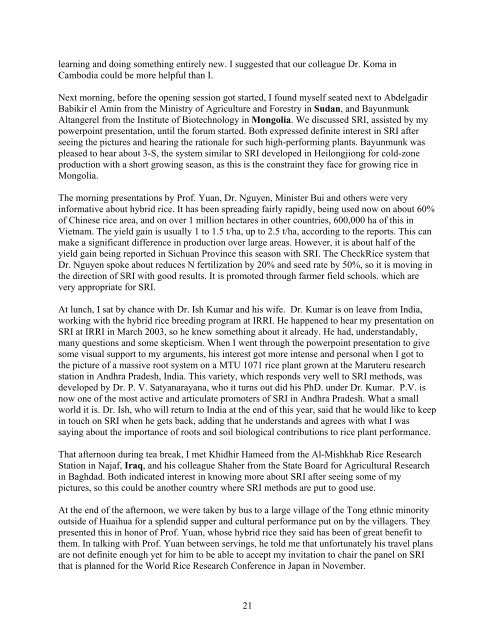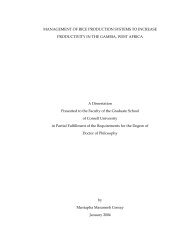Report from SRI China visit - The System of Rice Intensification ...
Report from SRI China visit - The System of Rice Intensification ...
Report from SRI China visit - The System of Rice Intensification ...
You also want an ePaper? Increase the reach of your titles
YUMPU automatically turns print PDFs into web optimized ePapers that Google loves.
learning and doing something entirely new. I suggested that our colleague Dr. Koma in<br />
Cambodia could be more helpful than I.<br />
Next morning, before the opening session got started, I found myself seated next to Abdelgadir<br />
Babikir el Amin <strong>from</strong> the Ministry <strong>of</strong> Agriculture and Forestry in Sudan, and Bayunmunk<br />
Altangerel <strong>from</strong> the Institute <strong>of</strong> Biotechnology in Mongolia. We discussed <strong>SRI</strong>, assisted by my<br />
powerpoint presentation, until the forum started. Both expressed definite interest in <strong>SRI</strong> after<br />
seeing the pictures and hearing the rationale for such high-performing plants. Bayunmunk was<br />
pleased to hear about 3-S, the system similar to <strong>SRI</strong> developed in Heilongjiong for cold-zone<br />
production with a short growing season, as this is the constraint they face for growing rice in<br />
Mongolia.<br />
<strong>The</strong> morning presentations by Pr<strong>of</strong>. Yuan, Dr. Nguyen, Minister Bui and others were very<br />
informative about hybrid rice. It has been spreading fairly rapidly, being used now on about 60%<br />
<strong>of</strong> Chinese rice area, and on over 1 million hectares in other countries, 600,000 ha <strong>of</strong> this in<br />
Vietnam. <strong>The</strong> yield gain is usually 1 to 1.5 t/ha, up to 2.5 t/ha, according to the reports. This can<br />
make a significant difference in production over large areas. However, it is about half <strong>of</strong> the<br />
yield gain being reported in Sichuan Province this season with <strong>SRI</strong>. <strong>The</strong> Check<strong>Rice</strong> system that<br />
Dr. Nguyen spoke about reduces N fertilization by 20% and seed rate by 50%, so it is moving in<br />
the direction <strong>of</strong> <strong>SRI</strong> with good results. It is promoted through farmer field schools. which are<br />
very appropriate for <strong>SRI</strong>.<br />
At lunch, I sat by chance with Dr. Ish Kumar and his wife. Dr. Kumar is on leave <strong>from</strong> India,<br />
working with the hybrid rice breeding program at IRRI. He happened to hear my presentation on<br />
<strong>SRI</strong> at IRRI in March 2003, so he knew something about it already. He had, understandably,<br />
many questions and some skepticism. When I went through the powerpoint presentation to give<br />
some visual support to my arguments, his interest got more intense and personal when I got to<br />
the picture <strong>of</strong> a massive root system on a MTU 1071 rice plant grown at the Maruteru research<br />
station in Andhra Pradesh, India. This variety, which responds very well to <strong>SRI</strong> methods, was<br />
developed by Dr. P. V. Satyanarayana, who it turns out did his PhD. under Dr. Kumar. P.V. is<br />
now one <strong>of</strong> the most active and articulate promoters <strong>of</strong> <strong>SRI</strong> in Andhra Pradesh. What a small<br />
world it is. Dr. Ish, who will return to India at the end <strong>of</strong> this year, said that he would like to keep<br />
in touch on <strong>SRI</strong> when he gets back, adding that he understands and agrees with what I was<br />
saying about the importance <strong>of</strong> roots and soil biological contributions to rice plant performance.<br />
That afternoon during tea break, I met Khidhir Hameed <strong>from</strong> the Al-Mishkhab <strong>Rice</strong> Research<br />
Station in Najaf, Iraq, and his colleague Shaher <strong>from</strong> the State Board for Agricultural Research<br />
in Baghdad. Both indicated interest in knowing more about <strong>SRI</strong> after seeing some <strong>of</strong> my<br />
pictures, so this could be another country where <strong>SRI</strong> methods are put to good use.<br />
At the end <strong>of</strong> the afternoon, we were taken by bus to a large village <strong>of</strong> the Tong ethnic minority<br />
outside <strong>of</strong> Huaihua for a splendid supper and cultural performance put on by the villagers. <strong>The</strong>y<br />
presented this in honor <strong>of</strong> Pr<strong>of</strong>. Yuan, whose hybrid rice they said has been <strong>of</strong> great benefit to<br />
them. In talking with Pr<strong>of</strong>. Yuan between servings, he told me that unfortunately his travel plans<br />
are not definite enough yet for him to be able to accept my invitation to chair the panel on <strong>SRI</strong><br />
that is planned for the World <strong>Rice</strong> Research Conference in Japan in November.<br />
21
















